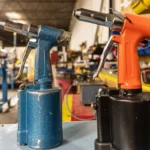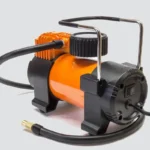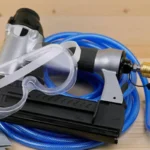Ever wondered why your air tools aren’t delivering the punch they promised? It’s not always about the brand you pick; sometimes, it’s all about how you handle what you’ve got. This guide is set to debunk some myths and tune-up your knowledge on maximizing air tool performance, ensuring that every squeeze of the trigger delivers top-notch results.
Understanding Your Air Tools
Air tools, powered by compressed air rather than electricity, offer a lightweight, powerful alternative for everything from home garages to industrial workshops. Unlike their electric counterparts, air tools require a bit more finesse in terms of setup—think of them as the high-performance sports cars of the tool world; they’re fast and effective but need the right fuel, pressure, and maintenance to keep them running smoothly.
Optimal Air Pressure Management
Just right—that’s how your air tool’s pressure settings need to be. Most air tools operate optimally at around 90 PSI. Too high, and you might wear them out prematurely; too low, and they won’t have enough oomph.
A reliable air regulator can help maintain this delicate balance, acting like a thermostat for your tools’ climate control, keeping the pressure just perfect for peak performance.
Airflow Rate Essentials
Think of CFM (Cubic Feet per Minute) as the breath of your workshop setup—your tools need the right amount to stay alive. If a tool doesn’t get its required CFM, it’s like trying to run a marathon on a single breath—not going to end well, right? For precision, focus on SCFM (Standard Cubic Feet per Minute), which accounts for temperature and humidity, ensuring your tools don’t experience performance dips due to environmental changes.
Effective Air Compressor Management
Your air compressor is the heart of your setup; it needs to be strong enough to support all the tools it feeds. Size matters—the tank should be big enough to handle simultaneous uses without pressure drops.
Regular maintenance is like giving your compressor a gym membership, keeping it fit and robust to handle the heavy lifting required to keep your tools running at their best.
Hose and Coupling Integrity
The lifelines of your air tools are the hoses and couplings that deliver the air. It’s crucial to select high-quality hoses that resist kinks and leaks, which can diminish air pressure and tool performance.
Think of couplings as the unsung heroes, connecting the dots between your compressor and tools. Opt for high-grade couplings that ensure a tight seal; this will prevent air leakage—a small step that avoids big performance drops.
Contamination Prevention
Dirty air is the nemesis of air-powered tools. Using clean, dry air is vital, which means installing proper filtration systems like aftercoolers and dryers is non-negotiable. These systems combat moisture and particulate matter, keeping your tools in fighting shape far longer.
Remember, pure air keeps your tools ready for battle against wear and tear.
Lubrication and Maintenance
Lubrication in air tools is like hydration for athletes; it keeps them running smoothly. Regular oiling prevents the internal components from grinding down, which can lead to overheating and failure. Follow a lubrication schedule as religiously as a pit crew does a race car’s maintenance. Equally, routine check-ups help catch issues before they escalate into costly repairs.
Storage Solutions
Store your air tools as you would a fine Scotch—properly and with care. Dust and moisture can turn your tools from prized possessions into rusted relics. Always clean and dry your tools before storing them in a cool, dry place. If you’re not using them regularly, cover the air inlets to keep dust out and cap them off to prevent unwanted guests.
Regular Upkeep and Troubleshooting
Keeping a regular maintenance diary for your tools can help you avoid the frustration of unexpected breakdowns. This includes checking for signs of wear, making sure air filters are clean, and replacing any parts that look worse for wear. Troubleshooting common issues like a drop in performance often can be resolved by checking for air leaks or ensuring the tool is adequately lubricated.
Efficiency in the workshop isn’t just about working harder; it’s about working smarter. By following these guidelines, your air tools will not only last longer but also work better, ensuring that your projects are completed to the highest standard with the least fuss. Remember, good tool care is the hallmark of a true professional.

Matthew Dowell
Matthew, a seasoned builder from a family of craftsmen, leads Tools Trove. His passion for tools and decades of hands-on experience fuel his commitment to providing expert reviews and insightful content. Whether you’re a pro or a DIY enthusiast, Matthew’s guidance ensures informed decisions in the world of tools.




